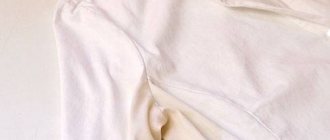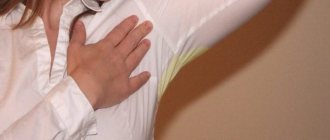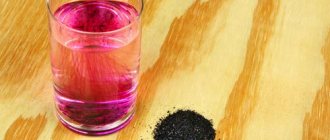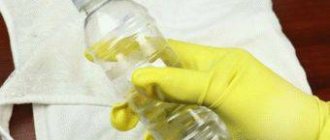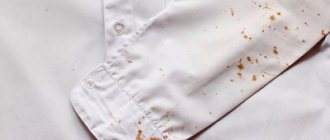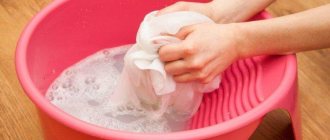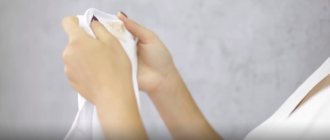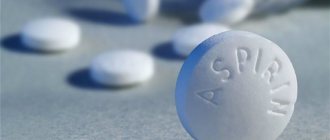A normal person is unlikely to be happy about the appearance of yellow spots on things after wet cleaning. Even if you follow all the recommendations, you can remove fabric with unpleasant marks from the drum, which has to be sent to the wash again. There may be several reasons behind the appearance of untidy marks. To determine the root cause of their occurrence, you need to understand where they are located, how easily they are washed off, and which things in the load got dirty and which remained pristinely clean. Similar problems arise if cosmetics (foundation, sunscreen) get on the fabric, traces of sweat appear, or the washing powder does not dissolve well and leaves yellowish marks on the laundry.
Why do yellow spots appear on white things?
Yellow spots appear both on things that are worn regularly and on clothes that have been lying in the closet for a certain time. Therefore, there are many reasons for the appearance of unaesthetic marks on fabric:
- sweating;
- secretion of sebum;
- use of low-quality hygiene products, including deodorants;
- applying a greasy cream that is poorly absorbed shortly before going out;
- perfume getting on fabric;
- non-compliance with temperature conditions when washing;
- use of low-quality detergents;
- untimely washing;
- detergent residues on the fabric due to insufficient rinsing;
- drying in direct sunlight
- pollution;
- long-term storage;
- high humidity in the room where things are stored.
Rusty tap water
If rust stains appear on your clothes, you should definitely check the condition of the water entering the machine from the water supply. The easiest way is to hold a white cloth under running tap water for a while. If after 5-7 minutes a characteristic rusty stain forms on the fabric, the water is too rich in iron, which causes contamination of the laundry during washing. In this case, a special filter must be installed on the pipe leading to the machine, which will bind metal particles. As a last resort, if it is not possible to install a filter or it does not cope with this task, before washing it is necessary to drain the stagnant water from the water supply for at least 30 minutes.
How to remove old and fresh yellow stains from white fabric
Getting rid of yellow spots is not so easy, especially if the stain is old. Fresh and mild marks can be removed using regular laundry detergents, but stubborn stains may require more radical methods.
Household chemicals
Laundry is one of the main household chores, as it is done several times a week. Every home will have some household chemicals, but if they are not there, you can go to the nearest store and choose a suitable option.
Laundry soap
An effective product that helps remove sweat stains and odors from fabrics and other types of dirt is laundry soap. Has pronounced disinfectant properties.
First way:
- Rinse things in warm water.
- Rub the contaminated areas with laundry soap.
- Rub gently.
- Leave for 40 minutes.
- Wash.
Second way:
- Finely rub laundry soap.
- Place 10 liters in a basin. hot water.
- Put 5 tbsp. l. grated soap.
- Make sure the soap is completely dissolved.
- Cool the solution to 30 degrees.
- Place things in a basin and rub the stains.
- Soak for 30 minutes.
- Rub contaminated areas.
- Wash clothes.
Stain remover
Stain remover is considered one of the most effective means against pollution of any complexity. However, this substance is quite aggressive, so it is undesirable to often resort to its help. It is better to use only to combat old and stubborn stains.
Stain removers can be found in the assortment of many popular manufacturers, for example, Vanish, Ushasty Nyan, Bos and others. Release forms:
- powder;
- gel;
- solution.
The method of application depends on the specific product. All necessary information is indicated in the instructions. As a rule, the contaminated area is moistened, a stain remover is applied and left to act.
Bleach
Allows you not only to remove dirt, but also to get rid of gray deposits on fabrics and restore freshness. Bleach is produced in the form of powders and liquids by manufacturers such as Vanish, Belizna, ACE and others.
The method of application depends on the specific product and is indicated in the instructions.
Bleach is mainly used under the following conditions:
- Dilute the product in water.
- Soak things.
- Rinse.
- Wash.
Folk remedies that can remove stains at home
Traditional methods are considered an alternative to household chemicals. Such products have a more gentle and natural composition. However, you must prepare everything correctly and follow the instructions to get the desired result.
Soda
Copes with traces of sweat, as well as yellow plaque and old stains on things. In addition, it softens the material and makes it fresher. Suitable for all types of fabrics, including delicate ones.
- Dilute 3-5 tbsp. l. soda with water until the consistency of thick porridge.
- Apply the mixture to contaminated areas and rub lightly.
- Leave for 15-30 minutes depending on the degree of contamination.
- Rinse off.
- Wash.
Aspirin
Acetylsalicylic acid has a pronounced whitening effect, so it is effective against stains of varying complexity.
Aspirin helps remove traces of sweat, as well as yellow plaque from old things. Suitable for all types of fabrics.
- Crush 10 aspirin tablets.
- Dissolve in 15 l. warm water.
- Place things in the solution and leave for 8-12 hours.
- Wash.
Hydrogen peroxide
Hydrogen peroxide has a destructive effect on yellow plaque and stains. However, the substance does not harm the fabric and is therefore often used to bleach cashmere, wool, silk and other delicate materials.
- Dilute in 10 l. water 8 tbsp. l. salt, 2 tbsp. l. hydrogen peroxide and 2 tbsp. l. powder for white clothes.
- Place clothes in the solution and leave for 3-4 hours.
- Rinse thoroughly and wash.
Hydrogen peroxide is also used to bleach linen, cotton and synthetic fabrics. In this case, machine washing is recommended.
- Add 10-15 ml to the laundry detergent. hydrogen peroxide per 25 ml. water.
- Pour into the main wash compartment.
- Set the temperature to 70-80 degrees.
- Spin on quick wash.
Mustard powder
The best option for bleaching and removing yellow stains from wool and silk. Mustard powder also copes with gray plaque and traces of fat.
- Dilute in 5 l. boiling water 5 tbsp. l. mustard powder.
- Leave the solution for 2 hours.
- Strain.
- Place things in the solution.
- Leave for 2-3 hours.
- Rinse and wash.
Ammonia
It is considered a worthy alternative to aggressive stain removers. Ammonia is an effective remedy against complex stains, but has one drawback - an unpleasant odor during use. However, ammonium hydroxide is often used to clean collars and cuffs on white shirts. The substance also softens water and is suitable for washing all fabrics, even the most delicate ones.
First way:
- Dilute 5 tbsp. l. ammonia in 5 liters. water.
- Soak things for 2 hours.
- Wash.
Second way:
- Mix 1 tsp. ammonia and 4 tsp. glycerin.
- Apply the mixture to the stains.
- Leave for 40-60 minutes.
- Rinse and wash things.
Lemon acid
Store-bought bleaches and stain removers can be replaced by citric acid. The product copes with traces of sweat, old yellow spots and complex dirt.
Also helps remove yellow iron stains. Suitable for all types of fabrics, but when washing delicate items it must be diluted with soda.
First way:
- Dilute in 100 ml. water 15 g citric acid.
- Heat the solution to 60-70 degrees.
- Dip the contaminated area into the solution and leave for 10-15 minutes.
- Wash the clothes.
Second way:
- Rub the stain with lemon juice.
- Leave for 15 minutes.
- Wash the clothes.
Third way:
- Dilute in 1 liter. water 3-4 tbsp. l. citric acid. When washing delicate fabrics, add 3-4 tbsp. l. soda
- Soak for 15-20 minutes.
- Rinse thoroughly and wash.
You can clearly see how aspirin removes yellow stains from clothes in the video.
Video
To prevent yellow stains on clothes from bothering you anymore, follow the rules for caring for them and use our recommendations and recipes. Of course, you can take things to the dry cleaner, but believe me, old stains there will be marked as difficult to remove, which means you will not receive any guarantee for their removal. So take matters into your own hands and prove to everyone that old things have the right to “life”, and yellow spots are not a hindrance to them.
Source of the article: https://historyclothing.ru/pyatna/kak-vyvesti-zheltye-pyatna-s-odezhdy-kotoraya-dolgo-lezhala.html
How to remove old yellow stains from clothes | Ideal home, How to wash yellowed things from time to time.
What to do if yellow spots appear on white clothes after washing
Yellow stains on clothes may appear even after washing. This happens for several reasons:
- use of low-quality detergents;
- improper use of laundry detergents, especially bleaches;
- poor rinsing of items after washing;
- using excessive amounts of powder;
- hard water;
- high temperature conditions.
There are several ways to get rid of pollution.
- Additionally, wash items with oxygen bleach. This is especially true if yellow spots appear after washing at a high temperature.
- Mix 1 tsp. hydrogen peroxide and water. Apply the mixture to the stains, leave for 15-20 minutes and rinse.
- Dilute in 1 liter. water 2 tbsp. l. salt. Soak the items for an hour and wash as usual.
- Moisten the contaminated area with a 9% vinegar solution and rub with laundry soap. Leave for 20 minutes and wash.
Helpful Tips:
- Over time, yellow spots appear on white tulle. To get rid of them, use folk recipes: add a small amount of blue (1 capful) to water and stir thoroughly. Immerse the tulle in the solution and then rinse.
- You can bleach stains from tulle using brilliant green: after washing, place the curtains in water with coarse table salt (3 tablespoons) and powder. Leave the tulle for 2 hours, add 3-4 drops of brilliant green, rinse the product. The curtain will not only get rid of stains, but will also become more elastic.
Recommendations for caring for white clothes
White items require special care. To preserve the original appearance for a long time, you must follow certain rules:
- Make sure that detergents are completely dissolved in water;
- do not wash white items at the highest temperature setting;
- rinse things thoroughly to remove any remaining powder and other detergents;
- use water softeners;
- periodically dry things that have been stored in the closet for a long time;
- try to wash clothes as they become dirty;
- Avoid products with chlorine, otherwise sweat stains may darken more;
- Avoid deodorants containing aluminum.
Clothes of light and dark shades get dirty equally, but on black and colored fabrics the dirt is not so noticeable.
Following care instructions, timely washing and proper storage of white items will reduce the likelihood of yellow stains appearing. However, it is not always possible to avoid contamination, and then traditional methods and household chemicals come to the rescue. If you wash things in time, yellow stains will easily come off the fabric.
Household chemicals
Special chemical agents—stain removers and bleaches—successfully solve the problem of yellow spots on white clothes. Liquid and gel products are suitable for light, delicate fabrics. The powder perfectly removes yellow stains from natural cotton and jeans.
Using the stain remover is easy:
- according to the instructions, dilute the drug in water;
- soak clothes;
- rinse the stain remover out of the fabric and wash the clothes as usual.
Rating of the most popular and effective means for removing stains from white clothes:
Liquid stain remover Vanish OXI Action . It will remove any dirt as quickly as possible, enhance the effect of washing powder, and refresh clothes.
The fairly high cost (150 rubles) is fully compensated by the quality and effectiveness of Vanish OXI Action. Bleach Bos plus Maximum . Gives a fresh smell, perfectly removes any dirt, and works at low temperatures.
The affordable price (60 rubles) makes Bos plus Maximum bleach popular among a wide range of consumers.
- Bleach SARMA Active . The product from a domestic manufacturer is ideal for all types of fabrics and does not contain chlorine. The average cost of SARMA Active bleach is 94 rubles.
Before using a chemical for the first time, you must carefully read the instructions and strictly follow all the manufacturer’s recommendations.
SMA breakdowns - causes of spots
The causes of contamination associated with the condition of the washing machine are indicated by dark marks. If you do not regularly care for the device, problems can appear from different sides. Let's consider cases of laundry contamination caused by technical problems and poor care of SMA.
The cuff is dirty
It is recommended to wipe the cuff regularly. If this is not done, dirt will accumulate in the fold of the cuff, and then mold will form - a gray coating will form. The result is gray marks. To fix the problem, clean the cuff with a brush. Do this carefully, but carefully, so as not to damage the cuff.
Oil seal leaked
If the washer leaks from the bearing side, the drum seal has probably failed. It should be replaced with a new one. As soon as the oil seal leaks, the device is stopped immediately, otherwise water will get on the bearings and they will rust. The oil seal must be replaced as soon as possible; if you delay, the bearings will rust and begin to creak and make other unpleasant sounds. Rust causes laundry to become dirty.
Replacing the oil seal requires replacing the bearings - this procedure is best left to professionals. If the tank is collapsible and the owner of the machine wants to change the damaged parts himself, you need to buy bearings - 2 pieces, and an oil seal. Select the right bearing - take out the old ones and look at their number, and then buy exactly the same or suitable analogues.
Due to worn seals, oil or fuel oil appears on washed clothes, since when these parts wear out, they release oil into the tank, which then ends up on the fabric.
Seal replacement procedure:
- Removing the top panel.
- Removing the bottom cover.
- Removing the front panel.
- Removing the rubber cuff.
- Disassembling the tank of the machine into two parts.
- Replacement of bearings and seals.
The tank is very fragile, so the bearings should be knocked out very carefully. New bearings are driven into places that have been previously polished to a shine. The new oil seal is lubricated with waterproof oil and inserted into place. Read more with photos and videos here.
The pump, tank or pipe is dirty
A clogged drain system is another reason things get dirty. The pump, tank and pipes can become clogged in two ways:
- Mechanical. By chance, foreign objects appear in the drain system, blocking its operation. These can be any small objects - coins, buttons, etc.
- Natural. These blockages form gradually - due to the ingress of wool, hair, lint, etc.
To clean the system, you need to:
- Clear the blockage in the garbage filter drain.
- If there is no debris in the drain, the SMA is disconnected from the power supply, water supply and drainage system - for ease of operation. Tilt the device to the left to get to the pump and pipes, which should also be checked for blockages.
- If no blockage is found there, remove the pump and then the motor to open the way to the main pipe leading to the waste filter.
- If there is no blockage in the pipe, you will have to contact a specialist to find out the origins of the problem.
How to clear the blockage yourself:
- Remove dirt or objects stuck in the system directly with your hand or something thin, such as a screwdriver. There can be many clogs, so removing one of them does not guarantee a solution to the problem.
- Along with mechanical cleaning, it is useful to chemically clean the system using a special cleaning agent. A drug, for example Dr. Beckmann, pour into the cuvette and turn on the machine in 90 degree mode. The product can be poured directly into the drum - if there is dirt on its walls.
Mold in the internal parts of the SMA
Lack of SMA care or improper care leads to the formation of mold. It can appear in various parts of the washing machine - in the detergent tray, in the cuff, in the drum, tank, pipes. Mold also causes stains.
Why does mold appear:
- closing the wet compartment for detergent;
- closing the drum door immediately after removing items.
Ventilating and drying the machine helps prevent the formation of mold - so, according to the user instructions, do not close the hatch door after using the machine for some time, but it is better to keep it ajar all the time.
You can guess the presence of mold by the smell - just sniff the “inside” of the drum. To find out where there is mold, proceed as follows:
- Unfold the cuff and inspect all the cracks.
- Inspect the inner walls of the drum.
- Look into the detergent drawer.
- Remove the cuvette and inspect it.
If you find a dark fluffy coating in at least one of the examined places, it will become clear where the gray dirt on the washed items comes from.
If there is mold in the washer, things will smell unpleasant even after using the best conditioner.
Procedure for removing mold:
- soda is poured into the cuvette - about 300 g;
- select the maximum water temperature;
- start the device at idle speed, turning on double rinsing.
The process is repeated until the mold is completely eliminated.
Rust
If a corrosive object gets stuck inside the washer, it can cause rust stains. For example, a nail, paper clip, or other small metal item that has fallen out of your pockets can rust. Once they get behind the cuff, they begin to rust there, and the owner of the SMA does not even suspect the presence of a small “saboteur” until he reveals himself. The user’s task is to quickly detect and remove a foreign object from a secluded place.
To prevent rust from forming inside the washer, water softeners are used.
To remove traces of rust, pour salt on top and then lemon juice. After a day, wash the soiled item. If this does not help, you will have to purchase a special stain remover.
If you choose and dose powders correctly and follow the operating rules of the washing machine, then the washing result will be what we expect. Any violation or lack of care for SMA can result in damage to things with further waste of time and effort to correct the consequences of negligence.
